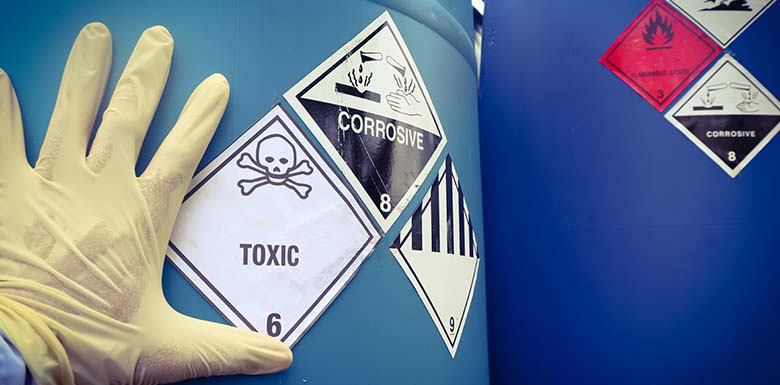Posted by: Kemmy Law Firm
The Occupational Safety and Health Administration (OSHA) estimates that more than 32 million workers are exposed to 650,000 hazardous chemical products in American workplaces. These chemicals are linked to many adverse health effects that could permanently impact your life.
Knowing what to do when exposed to harsh chemicals can help mitigate the effects and guide you toward medical treatments you may need to recover.
How Does OSHA Regulate Exposure to Chemicals?
Workers have the right to know which hazards they’re exposed to and how to protect themselves from harm. Furthermore, employers should try to prevent on-the-job injuries and long-term effects related to toxic exposure.
To mitigate the effects of toxins, OSHA sets permissible exposure limits that help protect workers. These are the highest levels of chemicals an employee can be exposed to without developing adverse health effects.
The Occupation Safety and Health Administration outlines four methods for controlling chemical exposure in the workplace:
- Elimination/Substitution – In some cases, employers may have to substitute chemicals for safer alternatives
- Engineering Controls – This involves implementing physical changes to the workplace that eliminates on-the-job hazards
- Administrative and Work Practice Controls – Employers can mitigate the effects of chemical exposure by rotating job assignments to avoid overexposing one worker to hazardous substances
- Personal Protective Equipment – Employers must provide workers with the necessary personal protective equipment to prevent the effects of chemical exposure. This might include respiratory protection, gloves, or protective eyewear
What Toxic Chemicals Could You Be Exposed to at Work?
Workers in all industries could be exposed to various toxic chemicals at work, which might include one more of the following depending on your industry:
- Hydrogen Sulfide – Hydrogen sulfide is a toxic gas common in the oil industry that’s released during drilling. This toxic gas could cause significant harm even when exposed to small amounts.
- Benzene – This is an odorless chemical or light-yellow liquid. Benzene is a natural part of crude oil and causes cells not to work properly. This leads to many health issues, including damage to the immune system.
- Silica – Crystalline silica is a mineral found in the earth’s crust that is used during the fracking process. Workers could inhale dust in the air that contains silica, which leads to respiratory issues.
- Asbestos – Historically, asbestos has impacted countless industries, from railroads to auto repair shops. Today, the construction industry is mainly affected by this toxic substance. Inhalation is the primary route of exposure.
- Sulfur Dioxide – This colorless gas impacts workers in factories that produce paper and other workers in industries where SO2 is a byproduct.
What Are the Effects of Toxic Chemical Exposure?
OSHA estimates that workers suffer more than 190,000 illnesses and 50,000 deaths related to chemical exposures annually. The symptoms and diseases someone might experience after toxic chemical exposure include the following:
- Various cancers
- Reproductive diseases
- Lung diseases
- Kidney diseases
- Skin diseases
- Heart disease
- Chemical burns
- Respiratory damage
What to Do if You’re Exposed to Toxic Chemicals at Work
- Apply First Aid – The CDC recommends several first aid procedures when workers are exposed to toxic chemicals. Toxins may have been inhaled or swallowed. In other cases, the chemicals could have come into contact with your skin or eyes. The affected area will determine the initial treatment.
- Seek Medical Treatment – After you’ve applied first aid and addressed the initial exposure, you should seek prompt medical attention. You could have damaged your respiratory system due to inhalation, or you could have severe chemical burns depending on the substance you came into contact with.
- Gather Available Evidence – This might not be realistic for everyone. However, any photos or videos you can take of where the incident occurred could be used to support your case. Additionally, get the contact information of anyone who witnessed the incident. Their testimony could provide more details of how the incident occurred.
- Report the Incident – Once you’ve received medical attention, you should immediately report the incident to your employer. This report could include critical facts of the incident, such as when and where the accident occurred.
- Contact an Attorney – You could suffer from significant damages after a toxic exposure incident that requires compensation. If your employer doesn’t offer workers’ comp benefits, you can only recover compensation through a personal injury claim.
Recover What You Lost with Kemmy Law Firm
The long-term effects of toxic chemical exposure cannot be underestimated, and your employer must ensure you’re safe at work. If your employer overly exposes you to toxic chemicals or otherwise compromises your health and safety, contact the lawyers at Kemmy Law Firm to help you recover what you lost. Call us today at 844-334–4388 to schedule your free consultation.
